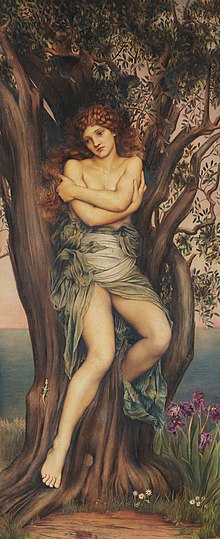Dryad

A dryad (/ˈdraɪ.æd/; Greek: Δρυάδες, sing. Δρυάς) is a tree nymph or tree spirit in Greek mythology; Drys (δρῦς) signifies "oak" in Greek. Dryads were originally considered the nymphs of oak trees specifically, but the term has evolved towards tree nymphs in general.[1] Often their life force was connected to the tree in which they resided and they were usually found in sacred groves of the gods.[citation needed] They were considered to be very shy creatures except around the goddess Artemis, who was known to be a friend to most nymphs.
Types
[edit]| Greek deities series |
|---|
| Nymphs |
Daphnaie
[edit]These were nymphs of the laurel trees.
Epimelides
[edit]The Maliades, Meliades or Epimelides were nymphs of apple and other fruit trees and the protectors of sheep. The Greek word melas, from which their name derives, means both apple and sheep. Hesperides, the guardians of the golden apples were regarded as this type of dryad.
Hamadryad
[edit]Dryads, like all nymphs, were supernaturally long-lived and tied to their homes, but some were a step beyond most nymphs. These were the hamadryads who were an integral part of their trees, such that if the tree died, the hamadryad associated with it also died. For these reasons, dryads and the Greek gods punished any mortal who harmed trees without first propitiating the tree-nymphs. (associated with Oak trees)
Meliae
[edit]The dryads of the ash tree were called the Meliae.[1] The Meliae sisters tended the infant Zeus in Rhea's Cretan cave. Gaea gave birth to the Meliae after being made fertile by the blood of castrated Uranus. The Caryatids were associated with walnut trees.[1]
Names
[edit]Some of the individual dryads or hamadryads are:
- Atlanteia and Phoebe, two of the many wives or concubines of Danaus[2]
- Chrysopeleia[3]
- Dryope[4]
- Erato[5]
- Eurydice
- Phigalia[6]
- Tithorea[7]
In popular culture
[edit]
- Keats addresses the nightingale as "light-winged Dryad of the trees", in his "Ode to a Nightingale" .
- In the poetry of Donald Davidson they illustrate the themes of tradition and the importance of the past to the present.[8]
- Dryads figure in C. S. Lewis' Chronicles of Narnia, where they are portrayed as loyal to Aslan the lion.[9]
See also
[edit]- Oreads, a related mountain nymph
- Ghillie Dhu, a similar Scottish spirit
- Kodama, a similar Japanese spirit
- Green spirit, a similar spirit found in Myanmar and other Buddhist countries
- Elf, a similar mythical creature associated with nature
- Plant soul, the soul of a plant in religious traditions
- Querquetulanae, Roman nymphs of the oak
- Rådande, a similar Swedish spirit
- Salabhanjika, a similar Indian spirit
- Mavka, a similar Ukrainian spirit
References
[edit]Citations
- ^ a b c Graves, ch. 86.2; p. 289
- ^ Apollodorus, 2.1.5
- ^ Tzetzes on Lycophron, 480
- ^ Ovid, Metamorphoses 9.330 ff; Antoninus Liberalis, 32
- ^ Pausanias, 8.4.2
- ^ Pausanias, 8.39.2
- ^ Pausanias, 10.32.9
- ^ Martha E. Cook (1979). "Dryads and Flappers". The Southern Literary Journal. 12 (1). University of North Carolina Press: 18–26. JSTOR 20077624.
- ^ Dryad: Mythical Creature Overview, Mythical Encyclopedia, accessed 16 April 2024
Bibliography
- Graves, Robert (1955). Greek Myths. London: Penguin. ISBN 0-14-001026-2.
- Burkert, Walter, 1985. Greek Religion (Cambridge: Harvard University Press).
External links
[edit]- Greek Mythology Link: Nymphs.
- Hans Christian Andersen, "The Dryad", 1868 (e-text)
- Andersen, H. C.; Craigie (transl.) "The Dryad" Fairy tales and other stories London; Toronto: Oxford University Press. 1914
- Tim Hoke, "The Dryad", 2002 (e-text; strong language)
